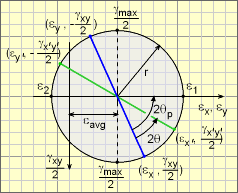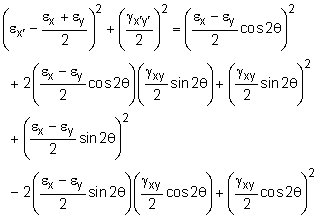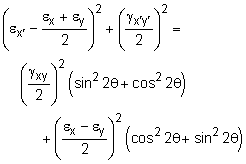| Ch 8. Strain Analysis | Multimedia Engineering Mechanics | ||||||
|
Plane Strain |
Mohr's Circle for Strain |
Strain Gages |
|||||
| Mohr's Circle for Strain | Case Intro | Theory | Case Solution | Example |
| Chapter |
| 1. Stress/Strain |
| 2. Torsion |
| 3. Beam Shr/Moment |
| 4. Beam Stresses |
| 5. Beam Deflections |
| 6. Beam-Advanced |
| 7. Stress Analysis |
| 8. Strain Analysis |
| 9. Columns |
| Appendix |
| Basic Math |
| Units |
| Basic Mechanics Eqs |
| Sections |
| Material Properties |
| Structural Shapes |
| Beam Equations |
| eBooks |
| Dynamics |
| Fluids |
| Math |
| Mechanics |
| Statics |
| Thermodynamics |
| ©Kurt Gramoll |
|
|
|||||
| Strain Rotation Equation |
|||||
|
|
Previously, the Strain transformation equations were developed to calculate the strain state at different orientations. These equations were Plotting these equations show that every 180 degrees rotation, the strain state repeats. In 1882, Otto Mohr noticed that these relationships could be graphically represented with a circle. This was a tremendous help in the days of slide rulers when using complex equations, like the strain transformation equations, was time consuming. |
||||
| Mohr's Circle |
|||||
|
|
Mohr's circle is not actually a new derived formula, but just a new way to visualize the relationships between normal strains and shear strains as the rotation angle changes. To determine the actual equation for Mohr's circle, the strain transformation equations can be rearranged to give, Each side of these equations can be squared and then added together to give
Grouping like terms and canceling other terms gives Using the trigonometry identity, cos22θ + sin22θ = 1, gives
|
||||
 Basic Mohr's Circle for Strain |
This is basically an equation of a circle. The circle equation can be better visualized if it is simplified to
This circle equation is plotted at the left using r and εave. One advantage of Mohr's circle is that the principal strains, ε1, ε2 , and the maximum shear strain, (γmax/2), are easily identified on the circle without further calculations. |
||||
| Rotating Strains with Mohr's Circle |
|||||
 Strain Rotation with Mohr's Circle |
In addition to identifying principal strain and maximum shear strain, Mohr's circle can be used to graphically rotate the strain state. This involves a number of steps.
|
||||
|
The angle, 2θp, for the principal strains is simply half the angle from the blue line to the horizontal axis. Remember, Mohr's circle is just another way to visualize the strain state. It does not give additional information. Both the strain transformation equations and Mohr's circle will give the exactly same values. |
|||||
Practice Homework and Test problems now available in the 'Eng Mechanics' mobile app
Includes over 500 free problems with complete detailed solutions.
Available at the Google Play Store and Apple App Store.







